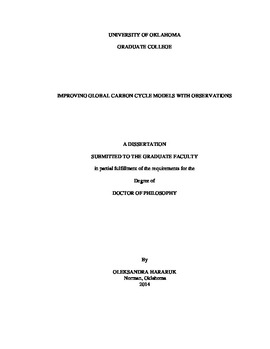| dc.description.abstract | In the future warming world terrestrial ecosystems may mitigate increasing temperatures by sequestering CO₂ from the atmosphere, or they can intensify future global change, amplifying the rate of CO₂ production in response to warming. Ecosystems’ response to climate change depends on controls over carbon (C) influx and storage, with the latter determined by ecosystem pools’ turnover rates. Global C cycle models perform well in predicting C influx rates, the gross and net primary productivity (GPP and NPP), however, their simulation of carbon storage requires improvement. This dissertation is focused on improving the models’ performance in simulating carbon storage and turnover rates.
In the first chapter I describe the importance of understanding the controls over ecosystem carbon storage; give an overview of current global carbon cycle model performance in C storage simulation; and describe benefits of data assimilation for model improvement. In the second chapter I focus on improving the modeled turnover rates of the surface leaf litter. I first illustrate the poor prediction of surface leaf litter turnover rates by a commonly used first-order decay model, then use a global observed dataset of litter turnover rates and a Bayesian Markov Chain Monte Carlo (MCMC) approach to calibrate the model. After calibration the model explained 43% of spatial variability in the observed litter turnover rates, which was better than the initial 15%. After calibration the nature of the structural lignin limitation of litter turnover rates became unrealistic, therefore I altered litter quality limitation function to be dependent on litter lignin-to-nitrogen ratio. The change in the litter quality limitation assumption led to further increase in the explained variability in the observations to 61%, and the estimated degree of lignin-to-nitrogen limitation of litter turnover rate was comparable to the values reported in literature. Lastly, model calibration resulted in reduction of temperature sensitivity of the litter turnover rates from Q10=2 to Q10=1.45.
In the third chapter I improve the simulation of soil organic carbon (SOC) storage in CLM-CASA’. Long-term land carbon-cycle feedback to climate change is largely determined by dynamics of SOC. However, most evaluation studies conducted so far indicate that global land models predict SOC poorly. I evaluated SOC predictions by CLM-CASA’, investigated underlying causes of mismatches between model predictions and observations, and calibrated model parameters using Bayesian MCMC technique to improve the prediction of SOC. I compared modeled SOC to observed soil C pools provided by IGBP-DIS globally gridded data product and found that CLM-CASA’ on average underestimated SOC pools by 65% (r²=0.28). I applied data assimilation to CLM-CASA’ to estimate SOC residence times, C partitioning coefficients among the pools, as well as temperature sensitivity of C decomposition. The model with calibrated parameters explained 41% of the global variability in the observed SOC, which was substantial improvement from the initial 27%. The projections differed between models with original and calibrated parameters: over 95 years the amount of C released from soils reduced by 48 Pg C, and the amount of C released from litter reduced by 6.5 Pg C. Thus, assimilating observed soil carbon data into the model improved fitness between modeled and observed SOC, and reduced the amount of C released under changing climate.
Despite calibration, CLM-CASA’ still explained only 41% of variability in the observed SOC, and that led me to explore alternative assumptions about SOC dynamics. CENTURY-type models (including CLM-CASA’) represent microbial activity via a fraction of the substrate pool, modified by an environmental limitation function. Alternatively, microbial models simulate heterotrophic respiration as a function of microbial biomass, environmental, and substrate limitation. In the fourth chapter I calibrated two microbial model formulations (a two- and a four-pool model) to global total soil organic carbon and microbial biomass pools, and compared the models’ performance to that of CLM-CASA’. Once calibrated, both microbial models explained 51% of variability in the observed soil carbon, which was 10% more than the amount explained by the calibrated CLM-CASA’. SOC in the microbial models was more sensitive to climate change than SOC in the CENTURY-type model: maximum likelihood magnitude of SOC decrease after 95 years of climate change was almost 5-fold higher in the microbial models than in CLM-CASA’. The uncertainties of SOC feedbacks to 95 years of climate change were also larger in the microbial models than in CLM-CASA’, which was due to non-linear and oscillatory dynamics in the microbial models.
These studies showed that current models did not perform well in simulating carbon dynamics in the dead organic matter pools, however their performance could be improved after calibration against the global observed datasets. In addition, using a Bayesian MCMC technique for model calibration allowed to generate parameter uncertainties, which could be propagated in the model to generate data-informed uncertainties for the modeled pools and their feedbacks to global climate change. It is essential to continue the efforts of calibrating and validating various model formulations using more globally observed datasets to identify models best representing reality and increase the confidence in the model projections. | en_US |
